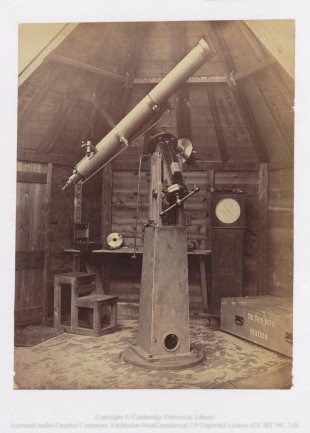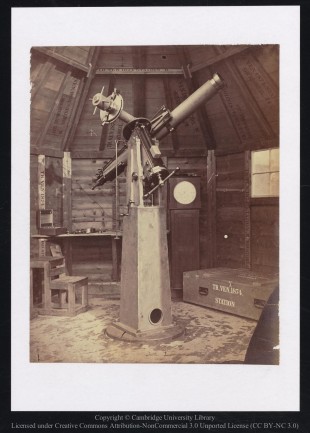…where east meets west
- Home
- Brief History
- The Greenwich Meridian
- Greenwich
(1675–1958) - Herstmonceux
(1948–1990) - Cambridge
(1990–1998) - Outstations (1822–1971)…
- – Chingford (1822–1924)
- – Deal
(1864–1927) - – Abinger
(1923–1957) - – Bristol & Bradford on Avon
(1939–1948) - – Bath
(1939–1949) - – Hartland
(1955–1967) - – Cape of Good Hope
(1959–1971)
- Administration…
- – Funding
- – Governance
- – Inventories
- – Pay
- – Regulations
- – Royal Warrants
- Contemporary Accounts
- People
- Publications
- Science
- Technology
- Telescopes
- Chronometers
- Clocks & Time
- Board of Longitude
- Libraries & Archives
- Visit
- Search
Telescope: Simms No.1 & Simms No.2 (6-inch equatorials)

Despite the fact that the telescope shown in this photograph and the one below is in a hut marked Station B, it is thought to be one of the two Simms 6-inch equatorials. This attribution is based on the fact that it was so identified by Forbes (who was on the expedition to the Sandwich Islands) in his book The Transit of Venus (published 1874) and also on two other photographs of what are said to be a Transit of Venus Equatorial by Troughton and Simms (one in a hut marked station C?) which are in the collections of the Science Museum in London. Reproduced under the terms of a Creative Commons Attribution-Non-Commercial (CC BY-NC) licence courtesy of Cambridge Digital Library (see below)

The telescope is on a German mounting. In this image, it is on the eastern side of the meridian. In the top image, (which was reproduced as a woodcut, in the 27 June 1874 edition of The Graphic) it has been reversed and is on the western side. A third, wider angle photograph, was also published as a woodcut in Forbes' book. Reproduced under the terms of a Creative Commons Attribution-Non-Commercial (CC BY-NC) licence courtesy of Cambridge Digital Library (see below)
The 1874 Transit of Venus expedition
The British set up five Stations across the globe from which to observe the 1874 Transit.Designated stations A to E, the locations were:
Station A – Egypt
Station B – Hawaiian (Sandwich) Islands
Station C – Rodriguez Island
Station D – New Zealand
Station E – Kerguelen Island
The two Simms Equatorials were sent to Station C (Rodriguez Island) and Station D (New Zealand). Referred to inititially as the C and D equatorials, Simms No.1 is believed to have been sent to the former and Simms No. 2 to the latter. On their return, the telescopes were put into store at Greenwich.
Transfer of the instruments from the British Government to the Royal Observatory
Together with many of the other Transit of Venus instruments, including the four other 6-inch Equatorials as well as two 4-inch Simms Equatorials (confusingly referred to as Simms detached No.1 and Simms detached No.2), the two 6-inch Simms instruments were formally transferred to the Royal Observatory in 1876. It was at this time that the two six-inch Simms instruments appear to have become formally known as Simms No.1 and Simms No.2, though the earlier designation was still ocassionally used. In 1876, the Station C Simms (Simms No.1?) was sent, together with a number of other of the Transit of Venus instruments, to the South Kensington Museum for their loan exhibition of Scientific Instruments (RGO6/278/670).
The 1882 Transit of Venus expedition
For the 1882 Transit, one of the six-inch Simms (together with the Hodgson Equatorial) was sent to Barbados returning to Greenwich on 3 February 1883. The other, believed to be No.2, was sent to Madagascar (along with the Corbett Equatorial), returning on 31 January. Unfortunately, poor packing of this instrument led to damage to the declination circle and other parts during the return journey (RGO6/283).
Post 1882 history
After the 1882 Transit, it would appear that Simms No.1 spent most of its life in store at Greenwich and later at Herstmonceux. It did however have a number of outings on eclipse expeditions. In 1886 it was sent to the island of Granada and in the following year it was sent to Russia for the eclipse there. For the Russian eclipse, rather than use the original heavy mounting, the telescope was set up on a small portable mount instead. In 1893, it was lent out for the eclipse that occured on 16 April where it was used in the determination of the photometric intensity of the coronal light. It is from the account of that expedition (link below), that we learn that the telescope had a focal length of 78 inches. According to Howse (Greenwich Observatory, London 1975), Simms No.1 was still at the Observatory in 1975. It’s current whereabouts are unknown.
Apart from when it was was sent on the eclipse expedition to the island of Granada in 1886, from 1884/5 until 1891/2, Simms No.2 is recorded as being at the Bethnal Green Musuem. Other instruments were also loaned to the museum for all or part of this period. From 1892/3 to 1907/8 Simms No.2 is recorded in the Reports of the Astronomer Royal as being with the Science and Art Department (a subdivision of the Board of Trade, which in 1856 was absorbed by a new Education Department). From 1908/9 to 1909/10 it is recorded as being with the Board of Education. Since this was formed in 1899 and replaced the Education Department and the Science and Art Department, Christie clearly failed to properly update his reports from one year to the next!
In 1911/12, Simms No.2 was lent to Imperial College. Claimed by Howse to still be there in 1975, the last reference to it in the Reports of the Astronomer Royal was in that for 1956. Its current location is unknown.
Contemporary accounts
Transit of Venus, 1882. Report of the Committee appointed by the British government to superintend thearrangements to be made for the sending of expeditions at the government expense, and securing co-operation with the government expeditions for the observation of the Transit of Venus, 1882, December 6 (HMSO, 1887)
Image Licensing
The two images of the Simms Equatorial in a Transit of Venus hut at Greenwich are reproduced in compressed and slightly cropped form under the terms of a Creative Commons Attribution-NonCommercial 3.0 Unported License courtesy of Cambridge Digital Library (RGO6/276). Click here for the first image. Click here for the second image. Click here for an additional wider angle photograph that shows the houses in Park Vista in the background.
© 2014 – 2026 Graham Dolan
Except where indicated, all text and images are the copyright of Graham Dolan